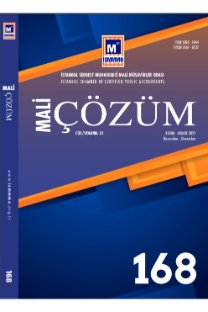TÜRKİYE’DE BANKACILIK SEKTÖRÜNDE TFRS 9 FİNANSAL ARAÇLAR STANDARDI’NIN UYGULANMA DÜZEYİNİN ANALİZİ
2008 yılında yaşanan ekonomik kriz, başta bankacılık sektörü olmak üzere tüm sektörleri etkilemiştir. Özellikle kredi zarar karşılıklarını göstermede yetersiz kalan “Türkiye Muhasebe Standardı (TMS) 39 Finansal Araçlar: Muhasebeleştirme ve Ölçme” standardı, kriz sonrasında eleştirilere maruz kalmıştır. Dolayısıyla bu standart yerine “Türkiye Finansal Raporlama Standardı (TFRS) 9 Finansal Araçlar” standardı yayımlanmıştır. Bu standart ile birlikte “beklenen kredi zararı” yaklaşımı benimsenmiştir. Bu çalışmanın amacı, Türkiye’de faaliyet gösteren mevduat, katılım, kalkınma ve yatırım bankalarında, TFRS 9 Finansal Araçlar standardının uygulanma düzeyi, standardın uygulanmasına geçiş sürecinde yaşanılan zorluklar ve sunduğu bilginin özelliklerini analiz etmektir. Çalışmanın analizinde veri toplama aracı olarak online anket yöntemi kullanılmış olup, söz konusu anket, bankacılık sektörü finansal raporlama bölümünde çalışan uzmanların görüşlerini öğrenmek için uygulanmıştır. Anket verilerinin analizinde SPSS 22.0 paket programı kullanılmıştır. Yapılan analiz sonucunda, TFRS 9’un uygulanmasına geçiş ile birlikte yaşanan en büyük zorluğun, uzmanlık düzeyinde bilgi gereksinimi; muhasebe alanında yaşanan en büyük zorluğun ise değer düşüklüğünün hesaplanması olduğu tespit edilmiştir. Standardın sunduğu bilginin özellikleri analizinin sonucunda ise, en fazla katılım sağlanan özellik “faydalı” bilgiye ait çıkmıştır. Ulaşılan bilgi özelliği sonucu, Kamu Gözetim Kurumu’nun TFRS 9’un amacına yönelik yaptığı tanımla örtüşmektedir.
ANALYSIS OF THE APPLICATION LEVEL OF TFRS 9 “FINANCIAL INSTRUMENTS” STANDARD IN THE BANKING SECTOR IN TURKEY
The economic crisis experienced in 2008 affected all sectors, especially the banking sector. “Turkey Accounting Standard (TMS) 39 Financial Instruments: Recognition and Measurement” standard, which remains insufficient to show the particular provisions for credit losses, has been subject to criticism in the wake of the crisis. Therefore, “Turkey Financial Reporting Standard (TFRS) 9 Financial Instruments” standard has been published instead of this standard. With TFRS 9, the “expected credit loss” approach has been adopted. The aim of this study is to analyze the level of implementation of the TFRS 9 Financial Instruments standard, the difficulties experienced during the transition to the implementation of the standard and the characteristics of the information it offers in deposit, participation, development and investment banks operating in Turkey. In the analysis of the study, the online survey method was used as a data collection tool, and the point at survey was applied to learn the opinions of the experts working in the financial reporting department of the banking sector. SPSS 22.0 package program was used in the analysis of the survey data. The results also indicate that it has been determined that the biggest challenge with the transition to the implementation of TFRS 9 is the need for knowledge at the level of expertise and the biggest challenge in the accounting field is the calculation of the impairment. As a result of the analysis of the characteristics of the information provided by the standard, the feature with the highest participation was found to be “useful” information. As a result of the obtained information feature, it overlaps with the definition made by the Public Oversight Authority for the purpose of TFRS 9.
___
- Albian, A. (2020). Loan Loss Provisioning and Market Discipline: Evidence from the IFRS 9 Adoption. SSRN Electronic Journal, 1-38.
- Deloitte (2016). IFRS in Focus, IFRS 9: Financial Instruments - High Level Summary. Erişim Adresi: https://www.iasplus.com/en/publications/ global/ifrs-in-focus/2016/ifrs-9 Erişim Tarihi: 28.10.2020.
- Gulyás, É. and Cintia S. (2019). Experiences Relating to the Introduction of IFRS 9 In the Banking Sector. Economy and Finance: English-Language Edition of Gazdaság És Pénzügy, 6(3), 266-295.
- Groff, Maja Zaman and Barbara Mörec (2020). IFRS 9 Transition Effect on Equity in a Post Bank Recovery Enviroment: The Case of Slovenia. Economic Research-Ekonomska Istraživanja, DOI: 10.1080/1331677X.2020.1804425.
- Huian, Maria Carmen (2012). Accounting For Financial Assets And Financial Liabilities According To IFRS 9. Annals of the Alexandru Ioan Cuza University – Economics, 59(1), 27-47. DOI: https://doi.org/10.2478/v10316- 012-0002-0.
- Karaaslan, S. ve Ozan G. (2020). TFRS 9’a Geçişin Türkiye’de Halka Açık Bankaların Finansal Durum Tablolarına Etkileri. Muhasebe ve Finansman Dergisi, 86, 111-124.
- TFRS 9 (2019). Türkiye Finansal Raporlama Standartları, TFRS 9 Finansal Araçlar (2019 sürümü), Erişim Adresi: https://www.kgk.gov.tr/ Portalv2Uploads/files/Duyurular/v2/TFRS/TFRS_2020/TFRS%209.pdf Erişim Tarihi: 25.10.2020.
- Köksal, M. Oğuz, A. H. ve Babuşçu Ş. (2020). TFRS 9 Kredi Karşılıkları Düzenlenmesinin Bankaların Finansal Tablolarına Etkisinin Analizi. Balıkesir Üniversitesi İktisadi ve İdari Bilimler Fakültesi Dergisi, 1(1), 27-54.
- KPMG (2018). IFRS 9: Transition impact on banks in the Gulf Cooperation Council. Erişim Adresi: https://assets.kpmg/content/dam/kpmg/ae/pdf/IFRS9- transition-impact-on-banks-in-the-gcc-uae.pdf Erişim Tarihi: 9.11.2020.
- Kund, A. G. and Daniel R. (2018). Does IFRS 9 Increase Financial Stability?. Available at SSRN: Erişim Adresi: http://dx.doi.org/10.2139/ ssrn.3282509 Erişim Tarihi, 16.11.2020.
- Limani, A. and Arian M. (2017). IFRS 9 & Key Changes With IAS 39. Erişim Adresi: https://www2.deloitte.com/content/dam/Deloitte/al/Documents/audit/ TKB-REVISTA-11_ENG_PRINT.pd.pdf Erişim Tarihi: 13.11.2020.
- Magdelana, Febriani Cristina Susianti ve Dwi Martini (2019). The Effect of IFRS 9 Adoption on Loan Loss Provisions. International Conference on Rural Development and Enterpreneurship 2019 : Enhancing Small Busniness and Rural Development Toward Industrial Revolution 4.0, 5(1), 705-712.
- Maggi, Fillippo, Alfonso Natale, Theodore Pepanides, Enrico Risso, and Gerhard Schröck (2017). IFRS 9: A Silent Revolotion in Banks’ Business Models. Erişim Adresi: https://www.mckinsey.com/business-functions/risk/ our-insights/ifrs-9-a-silent-revolution-in-banks-business-models Erişim Tarihi: 13.12.2020.
- Radström, N. and Neil E. (2019). The Implications of IFRS 9 - For Equity Analysts. (Yayımlanmamış Master Tezi), Uppsala Universty, İsveç.
- Sultanoğlu, Banu (2018). Expected Credit Loss Model By IFRS 9 and Its Possible Early Impacts On European And Turkish Banking Sector. Muhasebe Bilim Dünyası Dergisi, 20(3), 476-506.
- Us, Vuslat (2020). TFRS 9 Uygulamasının Seçilmiş Bankalar Bazında Kredi Sınıflandırması ve Karşılıkları Üzerindeki Etkisi. Finansal Araştırmalar ve Çalışmalar Dergisi, 12(22), 297-314.
- ISSN: 1303-5444
- Yayın Aralığı: Yılda 6 Sayı
- Başlangıç: 1991
- Yayıncı: İstanbul Serbest Muhasebeci Mali Müşavirler Odası
Sayıdaki Diğer Makaleler
İNDİRİMLİ ORANA TABİİ TESLİM ve HİZMETLERDEN KAYNAKLI KDV IADESI TALEPLERINDE MEVCUT SORUNLAR
Yıldırım Ercan ÇALIŞ, Nabi KÜÇÜKGERGERLİ, Ayşe ATILGAN SARIDOĞAN
ENGELLİ İŞÇİLER KISMİ SÜRELİ OLARAK ÇALIŞTIRILABİLİR Mİ?
KURUMLAR VERGİSİ KANUNU KAPSAMINDA ÜRETİM VEYA HİZMET İŞLETMELERİNİN KISMİ BÖLÜNMESİ: BİR UYGULAMA
TÜRKİYE’DE BANKACILIK SEKTÖRÜNDE TFRS 9 FİNANSAL ARAÇLAR STANDARDI’NIN UYGULANMA DÜZEYİNİN ANALİZİ
İŞ SÜRELERİNDEKİ ESNEKLİĞİN BİR YÖNÜ OLARAK TELAFİ ÇALIŞMASI
